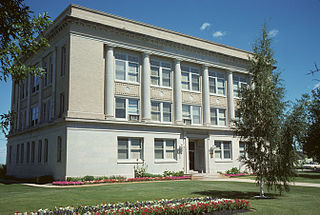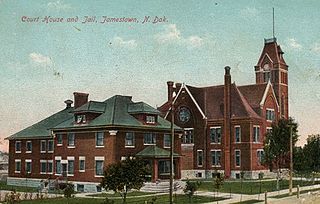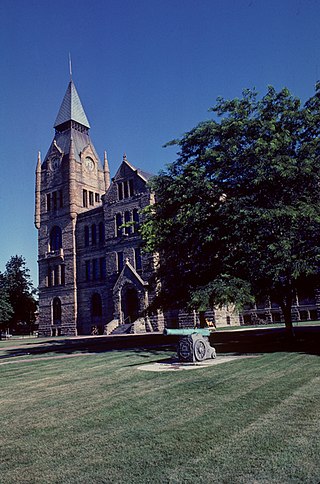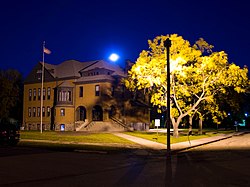
Steele County Courthouse in Finley, North Dakota was built in 1925. It was listed on the National Register of Historic Places in 1985.

Stark County Courthouse is a historic courthouse in Dickinson, North Dakota, United States, which was built in 1936–1937. It was added to the National Register of Historic Places on November 25, 1985.

Grand Forks County Courthouse is a Beaux Arts style building in Grand Forks, North Dakota, United States, that was listed on the National Register of Historic Places in 1980. It is a "richly decorated white limestone structure in a modified Classical Revival style, topped with a massive cast iron dome."

The Burleigh County Courthouse in Bismarck, North Dakota was designed in the Art Deco style by architect Ira Rush. It was built in 1931 and was listed on the U.S. National Register of Historic Places in 1985.

The Burke County Courthouse in Bowbells, North Dakota, was built in 1928. It was designed by the Minneapolis firm of Toltz, King, and Day, who also designed the Barnes County Courthouse and the Ward County Courthouse.

The Ward County Courthouse in Minot, North Dakota was built in 1929. Along with two other "distinctive county buildings in North Dakota", the Barnes County Courthouse and the Burke County Courthouse, it was designed by the Minneapolis, Minnesota, firm Toltz, King, and Day.

Theodore B. Wells (1889-1976) was an American architect. He was born in North Dakota. He studied at L'ecole des Beaux Arts. Back in North Dakota, he designed many public and commercial buildings.

The Benson County Courthouse in Minnewaukan, North Dakota was built in 1900. It was listed on the National Register of Historic Places (NRHP) in 1978.

The Dickey County Courthouse in Ellendale, North Dakota was built in 1910. It is in Beaux Arts architecture and was designed by architects Buechner & Orth. It was listed on the National Register of Historic Places (1980) in 1980.

The Eddy County Courthouse in New Rockford, North Dakota was built during 1899–1900. Designed by M.E. Beebe, the building is architecturally significant as "an outstanding example to the community of monumental public architecture". At the time of its National Register nomination in 1985, it was in "pristine condition".

The McHenry County Courthouse in Towner, North Dakota was built in 1907. Along with a number of other North Dakota courthouses designed by its architects Buechner & Orth, it was listed on the National Register of Historic Places in 1980.

The Foster County Courthouse in Carrington, North Dakota was built in 1909. It was designed by architects Buechner & Orth in Beaux Arts style. It was listed on the National Register of Historic Places in 1980. The listing includes two contributing buildings.

The Sargent County Courthouse in Forman, North Dakota was built in 1910. The courthouse of Sargent County, it was designed by architects Buechner & Orth in Beaux Arts style. It was listed on the National Register of Historic Places in 1980.

The McLean County Courthouse in Washburn, North Dakota was built in 1908. It was a 2+1⁄2-story brick building with a central tower above the front entrance. It was listed on the National Register of Historic Places in 1985. The listing included two contributing buildings.

The Towner County Courthouse in Cando, North Dakota is a historic Queen Anne-style building that was built in 1898. It was listed on the National Register of Historic Places in 1985.

The Stutsman County Courthouse and Sheriff's Residence/Jail in Jamestown, North Dakota was built in 1883. It was listed on the National Register of Historic Places in 1976.

The Walsh County Courthouse in Grafton, North Dakota was built in 1940. It was listed on the National Register of Historic Places in 1985.

The Woodson County Courthouse, located in Courthouse Square in Yates Center, serves as the administrative hub of Woodson County, Kansas. Established by the territorial legislature in 1857, Woodson County initially designated Neosho Falls as its inaugural county seat. However, between 1865 and 1875, the county seat underwent multiple relocations, shifting back and forth between Neosho Falls and Kalida, then to Defiance, before ultimately settling in 1876 at the newly established Yates Center, strategically positioned at the heart of the county.

The Galesburg Historic District is a 496-acre (201 ha) historic district in Galesburg, Illinois. The district includes 1049 contributing buildings and contains the town's original plat as well as several older neighborhoods. The section of the district south of North Street encompasses Galesburg's historic city center and its most significant landmarks, such as the Knox County Courthouse, the Knox County Jail, the Burlington Depot, and Main Street's commercial buildings. Knox College, the school Galesburg was founded to serve, and its historic Old Main are also located in the southern half of the district. The area north of North Street is mainly residential and is dominated by Queen Anne and Classical Revival houses, including many transitional houses displaying elements of both styles.

The Rutland Courthouse Historic District encompasses an architecturally cohesive area of civic and residential buildings in Rutland, Vermont. Roughly bounded by Court, Washington, South Main, and West Streets, the district was principally developed between 1850 and 1875, and includes a number of prominent municipal and county buildings, including the Rutland County courthouse, the Rutland Free Library, and the Grace Congregational United Church. The district was listed on the National Register of Historic Places in 1976.

























